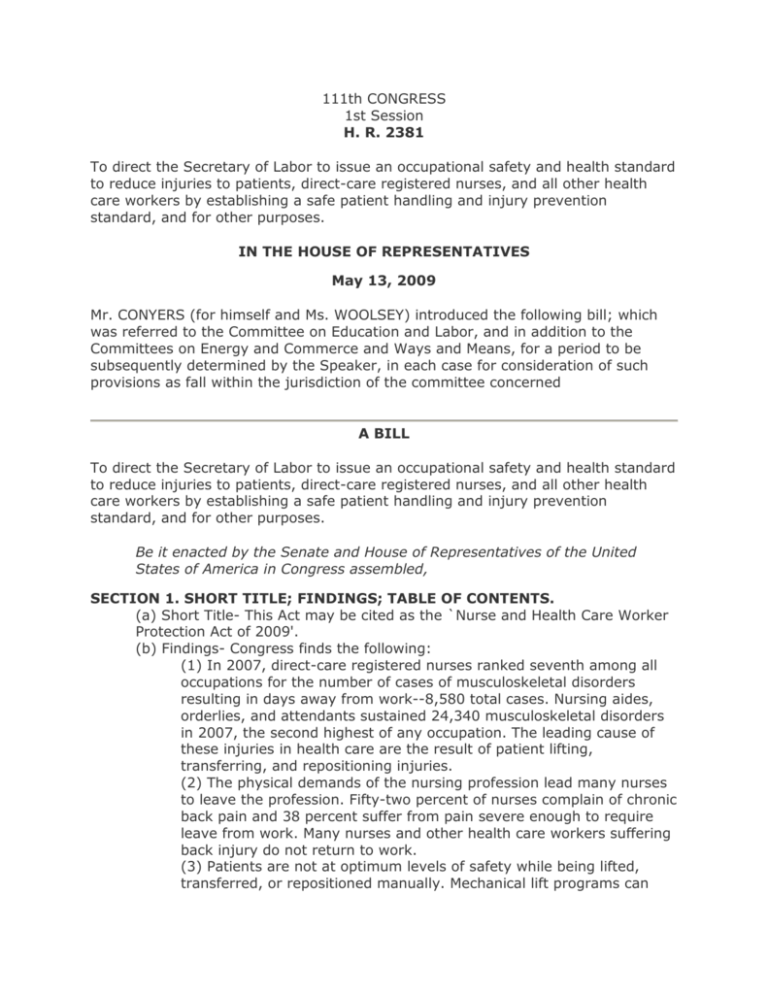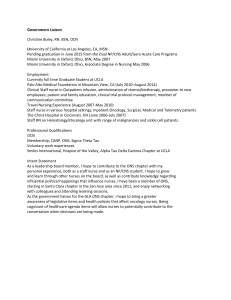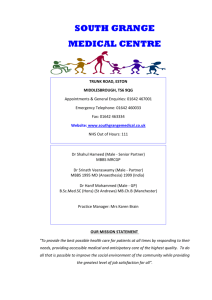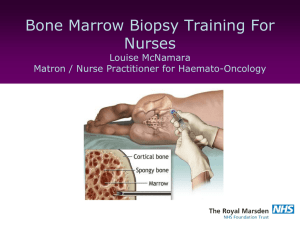sec. 3. protection of direct-care registered nurses and health care
advertisement

111th CONGRESS 1st Session H. R. 2381 To direct the Secretary of Labor to issue an occupational safety and health standard to reduce injuries to patients, direct-care registered nurses, and all other health care workers by establishing a safe patient handling and injury prevention standard, and for other purposes. IN THE HOUSE OF REPRESENTATIVES May 13, 2009 Mr. CONYERS (for himself and Ms. WOOLSEY) introduced the following bill; which was referred to the Committee on Education and Labor, and in addition to the Committees on Energy and Commerce and Ways and Means, for a period to be subsequently determined by the Speaker, in each case for consideration of such provisions as fall within the jurisdiction of the committee concerned A BILL To direct the Secretary of Labor to issue an occupational safety and health standard to reduce injuries to patients, direct-care registered nurses, and all other health care workers by establishing a safe patient handling and injury prevention standard, and for other purposes. Be it enacted by the Senate and House of Representatives of the United States of America in Congress assembled, SECTION 1. SHORT TITLE; FINDINGS; TABLE OF CONTENTS. (a) Short Title- This Act may be cited as the `Nurse and Health Care Worker Protection Act of 2009'. (b) Findings- Congress finds the following: (1) In 2007, direct-care registered nurses ranked seventh among all occupations for the number of cases of musculoskeletal disorders resulting in days away from work--8,580 total cases. Nursing aides, orderlies, and attendants sustained 24,340 musculoskeletal disorders in 2007, the second highest of any occupation. The leading cause of these injuries in health care are the result of patient lifting, transferring, and repositioning injuries. (2) The physical demands of the nursing profession lead many nurses to leave the profession. Fifty-two percent of nurses complain of chronic back pain and 38 percent suffer from pain severe enough to require leave from work. Many nurses and other health care workers suffering back injury do not return to work. (3) Patients are not at optimum levels of safety while being lifted, transferred, or repositioned manually. Mechanical lift programs can substantially reduce skin tears suffered by patients and the frequency of patients being dropped, thus allowing patients a safer means to progress through their care. (4) The development of assistive patient handling equipment and devices has essentially rendered the act of strict manual patient handling unnecessary as a function of nursing care. (5) A growing number of health care facilities have incorporated patient handling technology and have reported positive results. Injuries among nursing staff have dramatically declined since implementing patient handling equipment and devices. As a result, the number of lost work days due to injury and staff turnover has declined. Studies have also shown that assistive patient handling technology successfully reduces workers' compensation costs for musculoskeletal disorders. (6) Establishing a safe patient handling and injury prevention standard for direct-care registered nurses and other health care workers is a critical component in protecting nurses and other health care workers, addressing the nursing shortage, and increasing patient safety. (c) Table of Contents- The table of contents of this Act is as follows: Sec. 1. Short title; findings; table of contents. Sec. 2. Safe patient handling and injury prevention standard. Sec. 3. Protection of direct-care registered nurses and health care workers. Sec. 4. Application of safe patient handling and injury prevention standard to health care facilities not covered by OSHA. Sec. 5. Financial assistance to needy health care facilities in the purchase of safe patient handling and injury prevention equipment. Sec. 6. Definitions. SEC. 2. SAFE PATIENT HANDLING AND INJURY PREVENTION STANDARD. (a) Rulemaking- Not later than 1 year after the date of the enactment of this Act, the Secretary of Labor, shall, pursuant to section 6 of the Occupational Safety and Health Act of 1970 (29 U.S.C. 655), propose a standard on safe patient handling and injury prevention (in this section such standard referred to as the `safe patient handling and injury prevention standard') under such section to prevent musculoskeletal disorders for direct-care registered nurses and all other health care workers handling patients in health care facilities. A final safe patient handling and injury prevention standard shall be promulgated not later than 2 years after the date of the enactment of this Act. (b) Requirements- The safe patient handling and injury prevention standard shall require the use of engineering controls to perform lifting, transferring, and repositioning of patients and the elimination of manual lifting of patients by direct-care registered nurses and all other health care workers, through the use of mechanical devices to the greatest degree feasible except where the use of safe patient handling practices can be demonstrated to compromise patient care. The standard shall apply to all health care employers and shall require at least the following: (1) Each health care employer to develop and implement a safe patient handling and injury prevention plan within 6 months of the date of promulgation of the final standard, which plan shall include hazard identification, risk assessments, and control measures in relation to patient care duties and patient handling. (2) Each health care employer to purchase, use, maintain, and have accessible an adequate number of safe lift mechanical devices not later than 2 years after the date of issuance of a final regulation establishing such standard. (3) Each health care employer to obtain input from direct-care registered nurses, health care workers, and employee representatives of direct-care registered nurses and health care workers in developing and implementing the safe patient handling and injury prevention plan, including the purchase of equipment. (4) Each health care employer to establish and maintain a data system that tracks and analyzes trends in injuries relating to the application of the safe patient handling and injury prevention standard and to make such data and analyses available to employees and employee representatives. (5) Each health care employer to establish a system to document in each instance when safe patient handling equipment was not utilized due to legitimate concerns about patient care and to generate a written report in each such instance. The report shall list the following: (A) The work task being performed. (B) The reason why safe patient handling equipment was not used. (C) The nature of the risk posed to the worker from manual lifting. (D) The steps taken by management to reduce the likelihood of manual lifting and transferring when performing similar work tasks in the future. Such reports shall be made available to OSHA compliance officers, workers, and their representatives upon request within one business day. (6) Each health care employer to train nurses and other health care workers on safe patient handling and injury prevention policies, equipment, and devices at least on an annual basis. Such training shall include providing information on hazard identification, assessment, and control of musculoskeletal hazards in patient care areas and shall be conducted by an individual with knowledge in the subject matter, and delivered, at least in part, in an interactive classroom-based and hands-on format. (7) Each health care employer to post a uniform notice in a form specified by the Secretary that-(A) explains the safe patient handling and injury prevention standard; (B) includes information regarding safe patient handling and injury prevention policies and training; and (C) explains procedures to report patient handling-related injuries. (8) Each health care employer to conduct an annual written evaluation of the implementation of the safe patient handling and injury prevention plan, including handling procedures, selection of equipment and engineering controls, assessment of injuries, and new safe patient handling and injury prevention technology and devices that have been developed. The evaluation shall be conducted with the involvement of nurses, other health care workers, and their representatives and shall be documented in writing. Health care employers shall take corrective action as recommended in the written evaluation. (c) Inspections- The Secretary of Labor shall conduct unscheduled inspections under section 8 of the Occupational Safety and Health Act of 1970 (29 U.S.C. 657) to ensure implementation of and compliance with the safe patient handling and injury prevention standard. SEC. 3. PROTECTION OF DIRECT-CARE REGISTERED NURSES AND HEALTH CARE WORKERS. (a) Refusal of Assignment- The Secretary shall ensure that a direct-care registered nurse or other health care worker may refuse to accept an assignment from a health care employer if-(1) the assignment would subject the worker to conditions that would violate the safe patient handling and injury prevention standard; or (2) the nurse or worker has not received training described in section 2(a)(5) that meets such standard. (b) Retaliation for Refusal of Lifting Assignment Barred(1) NO DISCHARGE, DISCRIMINATION, OR RETALIATION- No health care employer shall discharge, discriminate, or retaliate in any manner with respect to any aspect of employment, including discharge, promotion, compensation, or terms, conditions, or privileges of employment, against a direct-care registered nurse or other health care worker based on the nurse's or worker's refusal of a lifting assignment under subsection (a). (2) NO FILING OF COMPLAINT- No health care employer shall file a complaint or a report against a direct-care registered nurse or other health care worker with the appropriate State professional disciplinary agency because of the nurse's or worker's refusal of a lifting assignment under subsection (a). (c) Whistleblower Protection(1) RETALIATION BARRED- A health care employer shall not discriminate or retaliate in any manner with respect to any aspect of employment, including hiring, discharge, promotion, compensation, or terms, conditions, or privileges of employment against any nurse or health care worker who in good faith, individually or in conjunction with another person or persons-(A) reports a violation or a suspected violation of this Act or the safe patient handling and injury prevention standard to the Secretary of Labor, a public regulatory agency, a private accreditation body, or the management personnel of the health care employer; (B) initiates, cooperates, or otherwise participates in an investigation or proceeding brought by the Secretary, a public regulatory agency, or a private accreditation body concerning matters covered by this Act; or (C) informs or discusses with other individuals or with representatives of health care employees a violation or suspected violation of this Act. (2) GOOD FAITH DEFINED- For purposes of this subsection, an individual shall be deemed to be acting in good faith if the individual reasonably believes-(A) the information reported or disclosed is true; and (B) a violation of this Act or the safe patient handling and injury prevention standard has occurred or may occur. (d) Complaint to Secretary(1) FILING- A direct-care registered nurse, health care worker, or other individual may file a complaint with the Secretary of Labor against a health care employer that violates this section within 180 days of the date of the violation. (2) RESPONSE TO COMPLAINT- For any complaint so filed, the Secretary shall-(A) receive and investigate the complaint; (B) determine whether a violation of this Act as alleged in the complaint has occurred; and (C) if such a violation has occurred, issue an order that sets forth the violation and the required remedy or remedies. (3) REMEDIES- The Secretary shall have the authority to order all appropriate remedies for such violations. (e) Cause of Action- Any direct-care registered nurse or other health care worker who has been discharged, discriminated, or retaliated against in violation of this section may bring a cause of action in a United States district court. A direct-care registered nurse or other health care worker who prevails on the cause of action shall be entitled to the following: (1) Reinstatement, reimbursement of lost wages, compensation, and benefits. (2) Attorneys' fees. (3) Court costs. (4) Other damages. (f) Notice- A health care employer shall include in the notice required under section 2(b)(7) an explanation of the rights of direct-care registered nurses and health care workers under this section and a statement that a direct-care registered nurse or health care worker may file a complaint with the Secretary against a health care employer that violates the safe patient handling and injury prevention standard, including instructions for how to file such a complaint. (g) Addition to Current Protections- The worker protections provided for under this section are in addition to protections provided in section 11(c) of the Occupational Safety and Health Act of 1970 (29 U.S.C. 660(c)). SEC. 4. APPLICATION OF SAFE PATIENT HANDLING AND INJURY PREVENTION STANDARD TO HEALTH CARE FACILITIES NOT COVERED BY OSHA. (a) In General- Section 1866 of the Social Security Act (42 U.S.C. 1395cc) is amended-(1) in subsection (a)(1)(V), by inserting `and safe patient handling and injury prevention standard (as initially promulgated under section 2 of the Nurse and Health Care Worker Protection Act of 2009)' before the period at the end; and (2) in subsection (b)(4)-(A) in subparagraph (A), inserting `and the safe patient handling and injury prevention standard' after `Bloodborne Pathogens standard'; and (B) in subparagraph (B), inserting `or the safe patient handling and injury prevention standard' after `Bloodborne Pathogens standard'. (b) Effective Date- The amendments made by subsection (a) shall apply to health care facilities 1 year after date of issuance of the final safe patient handling and injury prevention standard required under section 2. SEC. 5. FINANCIAL ASSISTANCE TO NEEDY HEALTH CARE FACILITIES IN THE PURCHASE OF SAFE PATIENT HANDLING AND INJURY PREVENTION EQUIPMENT. (a) In General- The Secretary of Health and Human Services shall establish a grant program that provides financial assistance to cover some or all of the costs of purchasing safe patient handling and injury prevention equipment for health care facilities, such as hospitals, nursing facilities, home health care, and outpatient facilities, that-(1) require the use of such equipment in order to comply with the safe patient handling and injury prevention standard; but (2) demonstrate the financial need for assistance for purchasing the equipment required under such standard. (b) Application- No financial assistance shall be provided under this section except pursuant to an application made to the Secretary of Health and Human Services in such form and manner as the Secretary shall specify. (c) Authorization of Appropriations- There are authorized to be appropriated for financial assistance under this section $200,000,000, of which $50,000,000 will be available specifically for home health agencies or entities. Funds appropriated under this subsection shall remain available until expended. SEC. 6. DEFINITIONS. For purposes of this Act: (1) DIRECT-CARE REGISTERED NURSE- The term `direct-care registered nurse' means an individual who has been granted a license by at least one State to practice as a registered nurse and who provides bedside care or outpatient services for one or more patients or residents. (2) HEALTH CARE WORKER- The term `health care worker' means an individual who has been assigned to lift, reposition, or move patients or residents in a health care facility. (3) EMPLOYMENT- The term `employment' includes the provision of services under a contract or other arrangement. (4) HEALTH CARE EMPLOYER- The term `health care employer' means an outpatient health care facility, hospital, nursing home, home health care agency, hospice, federally qualified health center, nurse managed health center, rural health clinic, or any similar health care facility that employs direct-care registered nurses or other health care workers.






